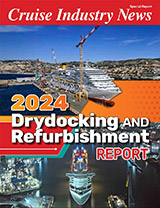New York City Economic Development Corporation (NYCEDC) and the Department of Parks and Recreation (DPR) today announced new measures to encourage greater use of City piers by historic and cultural vessels, and spur tourism.
In a potentially related matter, one bid to repurpose the SS United States involves bringing her to New York.
The initiative includes the release of streamlined docking protocols, a standard permit application, and consolidated information about 19 docking locations across the city. By hosting all of this information on the www.nyc.gov/waves website, historic vessel operators can more easily find comprehensive details on specific dock features such as: available public amenities; the types of docking (e.g. short-term or long-term stays); and the requirements for docking at each of the 19 available locations for historic vessels.
“The Bloomberg Administration is committed to reconnecting New Yorkers and visitors from around the world with our 520 miles of waterfront,” Deputy Mayor for Economic Development Robert K. Steel said. “By enabling more historic and educations vessels to dock in New York City we will bring visitors, jobs and investment to our waterfront.”
“Today’s announcement marks another important milestone in the Bloomberg Administration’s WAVES initiative, which is reconnecting New Yorkers to the City’s waterfront,” said New York City Economic Development Corporation President Seth W. Pinsky. “By providing better docking information for historic vessels and a standardized docking process, we will encourage greater use of the City’s piers and continue to enhance waterfront areas for residents and visitors alike.”
“NYC Parks offers some of the most popular destinations for local and visiting historic and cultural vessels,” said Parks & Recreation Commissioner Veronica White. “Thanks to the Bloomberg Administration’s WAVES initiative, access to our shared waterfront has expanded. Each year we host scores of marine education programs for school groups and the general public from our marinas and docks. As we continue to add dockage sites to support this increasing demand we are confident that these standardized policies and listing of available docks will help guide even more vessels and visitors to our waterfronts to experience New York City’s rich maritime heritage.”
“Hudson River Park has invested significantly in the infrastructure needed to safely accommodate historic vessels, because we view them as an essential part of the Park’s heritage,” said Madelyn Wils, President & CEO of Hudson River Park Trust. “The millions of tourists and visitors who visit Piers 25 and 84 here have been able to visit, enjoy and learn from the transient and long-term historic vessels located here, including, right now, the Tugboat Pegasus, Steamship Lilac and Nantucket Lightship. Hudson River Park is pleased to be working with the City on its efforts to promote historic and cultural vessels city-wide.”
“Brooklyn Bridge Park’s plan has always been to welcome historic vessels to piers 5 and 6 to enhance educational programming,” said Regina Myer, President of Brooklyn Bridge Park. “We are thrilled to be a part of this citywide initiative to formalize the permitting process and look forward to working with historic and cultural vessels in the future.”
“Governors Island is excited to welcome historic and educational vessels throughout our public season,” said Leslie Koch, President of The Trust for Governors Island.
“A uniform process for coordinating and permitting docking of tall ships, historic, educational and research vessels and other visiting vessels of all kinds is welcome news and long overdue,” said Capt John Doswell, Executive Director of the Working Harbor Committee. “This is a great step forward. Now we need to tell the maritime world how to take advantage of this so that we can attract these vessels, with their cultural and economic benefits, which now regularly avoid New York City.”
“For a more than a generation tall ships and other great historic ships have too often avoided the New York Harbor because it was viewed as an expensive, bureaucratic, and unwelcoming port that diminished our maritime heritage and robbed New Yorkers of the unique spectacle and economic stimulus those vessels bring,” Roland Lewis, President & CEO of the Metropolitan Waterfront Alliance. “This will change with the City’s new Historic Vessel Docking Inventory and Protocols. The Metropolitan Waterfront Alliance applauds the new maritime welcome mat and stands ready to help announce to the world the port of New York is once again read, able and eager to berth visiting vessels.”
Previously, each of the 19 piers, which are currently managed by NYCEDC, DPR, Hudson River Park Trust, Brooklyn Bridge Park, and the Trust for Governor’s Island, had their own standards and protocols for permitting historic vessels to dock, making it more difficult for historic vessels to find information and dock in New York City.
New York City’s waterfront has a rich maritime history that dates back to the 17th Century. Encouraging the use of docks by historic vessels offers an opportunity to showcase this maritime past and enliven the waterfront with educational programming and public events, which will help draw tourists and residents to the waterfront.
This initiative is part of the Waterfront Vision and Enhancement Strategy (WAVES), a citywide strategy launched by Mayor Bloomberg and Speaker Quinn, which lays out a sustainable blueprint for the City’s more than 500 miles of shoreline. WAVES has two core components: Vision 2020: The New York City Comprehensive Waterfront Plan, released a year ago, which established long-term goals for the next decade and beyond, and the New York City Waterfront Action Agenda, which set forth priority initiatives to be implemented by the end of 2013, many of which are being realized. Together, the initiatives provide a blueprint for the City’s waterfront and waterways, and focus on the following categories: open space and recreation, the working waterfront, housing and economic development, natural habitats, climate change adaptation and waterborne transportation.



